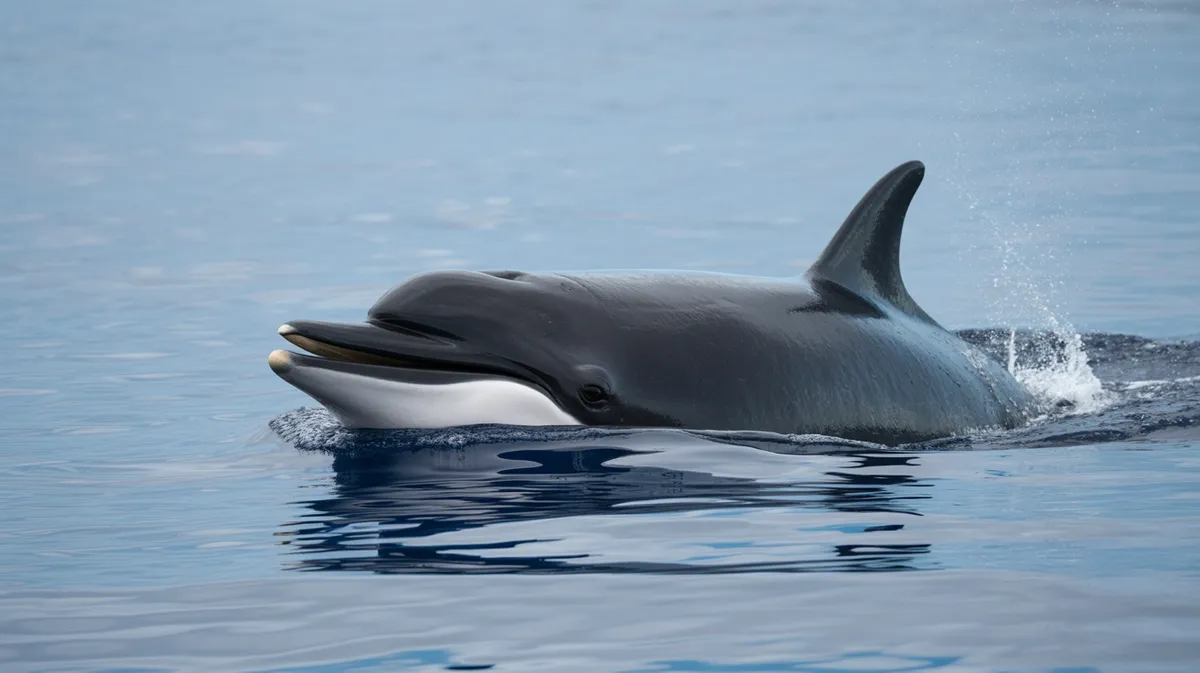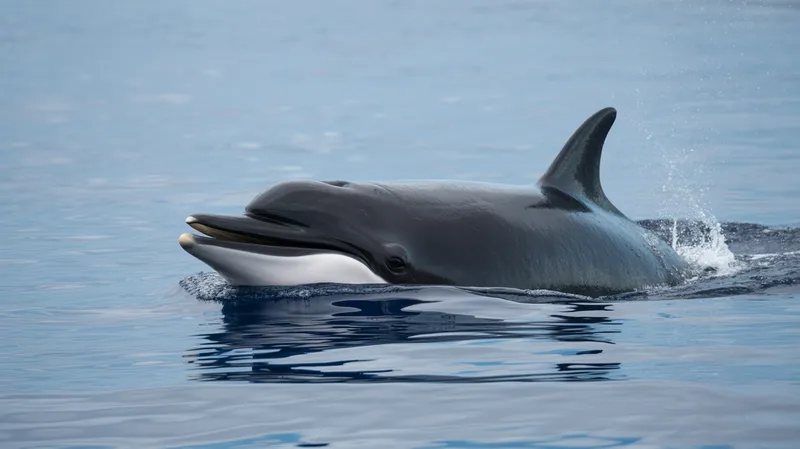
Southern Right Whale Dolphin
Lissodelphis peronii

Meet the Southern Right Whale Dolphin
The Southern Right Whale Dolphin is a striking, streamlined marine mammal known for its lack of a dorsal fin and stark black-and-white coloration. These dolphins inhabit the cool temperate waters of the Southern Hemisphere, often traveling in large, energetic groups that can number in the hundreds. They are fast, agile swimmers and are rarely seen leaping or bow-riding, preferring to surf in the wakes of waves and ships. With a slender body and long, narrow beak, they are uniquely adapted for life in the open ocean.
Classification
Mammal
Habitat
Open ocean (pelagic zone) of the Southern Hemisphere
Diet
Carnivore
Lifespan
15-25 years
Conservation
Least Concern
Weight
60-100 kg
📖Fascinating Facts
No Dorsal Fin
Southern Right Whale Dolphins are distinguished by the complete absence of a dorsal fin, a rare trait among dolphins.
Large Social Groups
They are highly social and often travel in pods of 100-1000 individuals, sometimes mixing with other cetaceans.
Swift Swimmers
These dolphins are swift and graceful, able to reach speeds of up to 22 km/h (14 mph) when traveling or escaping predators.
📋Detailed Description
The Southern Right Whale Dolphin (Lissodelphis peronii) is a highly distinctive small cetacean, notable for its slender, elongated body and complete absence of a dorsal fin—a rare trait among dolphins. Adults typically measure 2.0–3.0 meters in length and weigh between 60 and 100 kilograms, with males slightly larger than females. Their striking coloration consists of a sharply demarcated black dorsal surface and white ventral side, with the white extending along the flanks and under the chin, creating a bold contrast. The head is small and beakless, with a narrow, pointed rostrum and a relatively small mouth lined with 39–50 pairs of slender, conical teeth per jaw. Pectoral fins are small and recurved, while the tail flukes are narrow and pointed, aiding in swift, agile swimming. Southern Right Whale Dolphins are highly social, forming pods that can range from 10 to over 1,000 individuals, though groups of 100–200 are most common. These dolphins are known for their energetic swimming, often porpoising at the surface in rapid succession, and are capable of reaching speeds up to 25 km/h. They inhabit cool temperate to subantarctic waters of the Southern Hemisphere, typically between 30°S and 65°S latitude, and are most frequently observed in deep offshore regions. Their streamlined anatomy and lack of a dorsal fin are believed to reduce drag and facilitate high-speed movement through open ocean waters.
💡 Did you know?
Despite their name, Southern Right Whale Dolphins are not closely related to right whales; their name comes from their similar black-and-white coloration.
🔬Research & Sources
Wikipedia Summary
The southern right whale dolphin is a small and slender species of cetacean, found in cool waters of the Southern Hemisphere. It is one of two species of right whale dolphin. This genus is characterized by the lack of a dorsal fin. The other species, the northern right whale dolphin, is found in deep oceans of the Northern Hemisphere and has a different pigmentation pattern than the southern right whale dolphin.
Last Modified: 5/24/2025
🎭Behavior & Social Structure
Southern Right Whale Dolphins are highly gregarious and display complex social behaviors, often associating with other cetacean species such as dusky dolphins (Lagenorhynchus obscurus) and pilot whales (Globicephala spp.). They travel in tightly coordinated groups, surfacing and diving in synchrony, which may serve as a predator avoidance strategy. Feeding primarily occurs at or near the surface, but they are also capable of deeper dives to pursue prey. Their diet consists mainly of small mesopelagic fish (such as myctophids), squid, and occasionally crustaceans. Hunting is believed to be cooperative, with groups corralling prey into dense schools. Southern Right Whale Dolphins are less likely than other dolphins to approach boats for bow-riding but may be seen leaping in unison or riding the wakes of large waves and ships. Vocalizations include a range of clicks and whistles, though their acoustic repertoire is less well studied than that of other delphinids. Daily activity patterns are not fully documented, but they are thought to be diurnal, with feeding and socializing occurring throughout the day.
👶Reproduction & Life Cycle
Breeding in Southern Right Whale Dolphins is not fully understood due to the species' pelagic lifestyle and the difficulty of observing them at sea. Mating is believed to occur in austral summer and autumn (December to April), with a gestation period estimated at 10–12 months, similar to related delphinids. Calving likely peaks in late summer, with females giving birth to a single calf measuring about 1 meter in length. Calves are nursed for at least 6 months, during which time they remain closely associated with their mothers and the natal pod. Sexual maturity is reached at approximately 6–10 years of age. There is little evidence of extended parental care beyond weaning, but the strong social structure of pods may provide some protection for juveniles.
🛡️Adaptations & Survival
The most notable adaptation of Lissodelphis peronii is the complete absence of a dorsal fin, a trait shared only with its northern counterpart (L. borealis). This adaptation likely reduces hydrodynamic drag, allowing for more efficient, high-speed swimming in the open ocean. Their streamlined bodies, small pectoral fins, and narrow tail flukes further enhance maneuverability and speed. The bold black-and-white coloration may serve as disruptive camouflage against the dappled light of the ocean, confusing predators and prey. Their teeth are adapted for grasping slippery, fast-moving prey such as squid and small fish. Social adaptations include coordinated group movement and cooperative hunting, which increase foraging efficiency and reduce predation risk. Their vocalizations, though not as complex as some other dolphins, are adapted for communication in the open ocean environment.
📚Research Sources
🎨Cultural Significance
Due to their remote, offshore distribution, Southern Right Whale Dolphins have had minimal direct interaction with humans and do not feature prominently in indigenous folklore or maritime traditions. They are occasionally mentioned in the context of whale-watching in southern oceans, where their acrobatic group behavior is noted by observers. Unlike some other cetaceans, they have not been subject to commercial exploitation or significant cultural symbolism.
🔬Recent Research & Discoveries
Recent research has focused on refining population estimates using shipboard and aerial surveys, as well as photo-identification techniques. Genetic studies have confirmed the distinctiveness of Lissodelphis peronii from its northern relative, with limited gene flow between the two species. Acoustic research is ongoing to better understand their vocalizations and communication strategies. Satellite tagging and tracking studies are limited but have provided preliminary data on movement patterns and habitat use. There is growing interest in the species as an indicator of pelagic ecosystem health, given its reliance on mesopelagic prey and sensitivity to oceanographic changes.
🎥Wildlife Videos

Rare nature documentary from the 1980s - Southern Right Whale
Some great early footage of Argentina right whales with an equally great soundtrack! Note: I omitted Parts 4, 5 and 6 because ...
Andrew Warrick

Rare nature documentary from the 1980s - Southern Right Whale (2)
Andrew Warrick

Southern Right Whale Dolphins | Antarctica | Lindblad Expeditions-National Geographic
Guests spot a pod of nearly 1000 southern right whale dolphins -- an extremely rare sight -- off the bow of the Explorer. Video by ...
Lindblad Expeditions

"The Southern Right Whale" - Offical 2018 WCFF Trailer
"The Southern Right Whale|", produced Santiago Sainz-Trapaga and directed by Kevin Zaouali, screens as a World premiere at ...
Wildlife Conservation Film Festival

"Ocean Giants: Exploring Whales and Dolphins - PBS Nature Documentary Series"
"Embark on an extraordinary three-part series, 'Ocean Giants,' venturing on a global odyssey with acclaimed underwater ...
Tranquilites Ebb and Flow

Titans of the Deep - The Fascinating World of Whales | Free Documentary Nature
Titans of the Deep - The Fascinating World of Whales | Ocean Documentary Watch 'Ocean Stories' here: ...
Free Documentary - Nature
🌍Habitat Information
The Southern Right Whale Dolphin typically inhabits Open ocean (pelagic zone) of the Southern Hemisphere environments. Southern Right Whale Dolphins have adapted to their environments with specialized features and behaviors.
Primary Habitat:
Open ocean (pelagic zone) of the Southern Hemisphere
More detailed habitat information will be available soon.
🛡️Conservation Status
The Southern Right Whale Dolphin is currently classified as Least Concern. Conservation efforts are crucial for preserving this species for future generations.
Common Threats:
- 🏠Habitat loss and fragmentation
- 🌡️Climate change impacts
- 🎯Hunting and poaching
- 🏭Human-wildlife conflict
⚠️Threats & Conservation Challenges
Currently, the Southern Right Whale Dolphin faces relatively few direct threats and is classified as Least Concern by the IUCN. However, potential threats include incidental bycatch in pelagic trawl and drift net fisheries, particularly in the southern Atlantic and Pacific Oceans. Ocean noise pollution from shipping and seismic exploration may interfere with their communication and navigation. Climate change and associated shifts in ocean currents and prey availability could impact their distribution and food sources. There are no known targeted hunts for this species, but they may be vulnerable to entanglement in fishing gear. Population trends are poorly understood due to the species' offshore habits and lack of comprehensive surveys, but there is no evidence of significant decline at present.
🔬Scientific Classification
Scientific Name
Lissodelphis peronii
Classification Hierarchy
🔍 About Taxonomic Classification
Taxonomic classification is a hierarchical system used by scientists to classify and organize living organisms based on shared characteristics and evolutionary relationships.
The system moves from broad categories (Kingdom) to increasingly specific ones, with each animal's scientific name typically consisting of its Genus and species.
📝Community Notes
Share your observations and insights about the Southern Right Whale Dolphin with our community of wildlife enthusiasts.
Join Our Community
Sign in to share your observations and connect with fellow wildlife enthusiasts.
Sign In to ContributeNo community notes yet
Be the first to share your observations about the Southern Right Whale Dolphin!
Explore Southern Right Whale Dolphin
Select a tab above to learn more about this amazing animal.
📸Photo Gallery
No photos available for this animal yet.
🌟Discover More Wildlife
Continue your journey of discovery with more fascinating animals from our database
